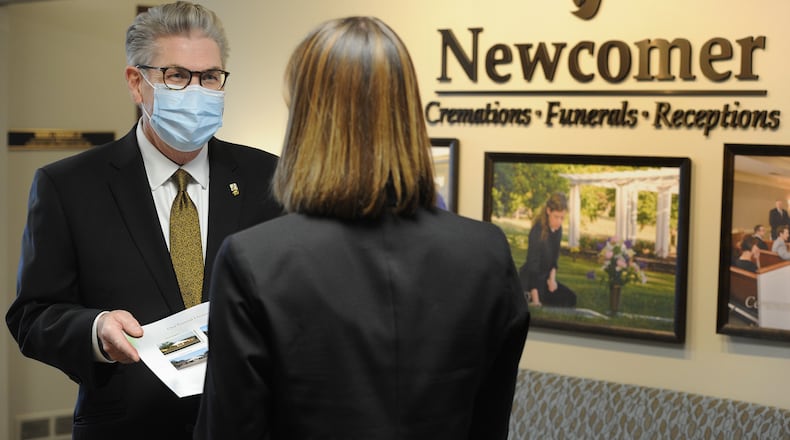“We’re a different kind of front line worker,” said Larry Glickler, who owns Glickler Funeral Home & Cremation Service in Dayton and has been a funeral director for about 45 years. “We’re taking care of the patient and the family after the death.”
He received two phone calls about people who had died from COVID-19 before 8 a.m. Thursday, in addition to the other deaths the funeral home was handling.
In October, the CDC reported nearly 300,000 excess deaths in the U.S. compared to the average number of people who died in recent years. About two-thirds of those deaths were counted as COVID-19 fatalities, indicating the pandemic was leading both directly and indirectly to deaths.
In Ohio, the CDC reports about 115,000 deaths from Feb. 1 to Dec. 12, which is about 107% of the number of deaths expected for that time frame compared to the average number of Ohio deaths across the same week in 2017–2019.
For Bryan Westbrock, an owner at Westbrock Funeral Home in Dayton and Kettering, the increase in COVID-related deaths has been more noticeable in the past month.
“We didn’t see any cases in our funeral home in the first three or four months of the pandemic, but certainly here in the last month, it’s increased tremendously,” he said.
The noticeable increase at Routsong Funeral Home and Cremation Services in Centerville and Kettering came earlier, funeral director Sam Routsong said.
“Things really started increasing for us back in late September or early October … we’ve been experiencing a higher number of families than usual – even adjusted for seasonality, still today,” he added.
In the early spring, “maybe we had one or two COVID cases” involving customers. But more recently, “I would say probably roughly a third of the families we’ve served have had COVID or actually passed from it,” Routsong said.
“We’re definitely busier. We’re working harder,” he added.
The number of COVID-19-related services and the impact it has had on funeral homes in Ohio varies depending on geography, Ohio Funeral Directors Association Executive Director Melissa Sullivan said.
“Because of the different surges in different areas of the state, some funeral homes have an increased number of families that they are meeting because of the increased deaths,” said Sullivan.
Through Thursday, the number of COVID-related deaths has been greatest in Cuyahoga (842), Franklin (693) Lucas (495), Summit (480) and Hamilton (401) counties, according to the Ohio Department of Health.
Montgomery ranked sixth (319), Butler was 10th (179), Clark was 11th (150), Warren 14th (101) and Greene 15th (100), ODH records show.
Safety precautions
Throughout the coronavirus pandemic, the OFDA has offered guidance to members providing services to meet families’ needs while doing so in a safe environment that protects customers and staff, she said.
Social distancing, mask-wearing and sanitation are stressed, Sullivan said.
A designated entrance and another for exits have been recommended where possible, Sullivan said, to avoid close contact.
Funerals and churches have been exempted from Ohio Gov. Mike DeWine’s limiting of gatherings to 10 people, according to Sullivan.
“But certainly our members have adopted what’s best for themselves and their community,” she said.
And families often voluntarily limit the number of guests or choose other alternatives, officials said.
Service options
Outdoor events or livestreaming options have also become more popular as fewer people attend indoor services, Routsong said.
He estimates 90% of families in recent months have chosen a livestream option, up from about two in 10 from the same time last year.
“Realistically, it’s probably something that we should have been offering sooner, because before COVID there were difficulties with families being across the country or even in another country,” he said.
“It’s probably sped up something that we should have been doing all along,” Routsong added.
Cremations have also increased, Westbrock said.
Jed Dunnichay, funeral director for Newcomer Cremations, Funerals & Receptions in Centerville, said the way people grieve initially shifted because of the pandemic, but now many of the families his business serves are opting for traditional services again.
“We are seeing more and more families opting for services and ceremonies to celebrate the lives of the family members that they have lost,” he said.
But he said they also have the staff and space to adequately serve their families, even though they are working much longer hours.
Funeral homes, Sullivan said, have “tried to modify or adapt their typical services or arrangements and how they do care for the individual – for the decedents as well as the family and the public in keeping everybody safe in the process.”


